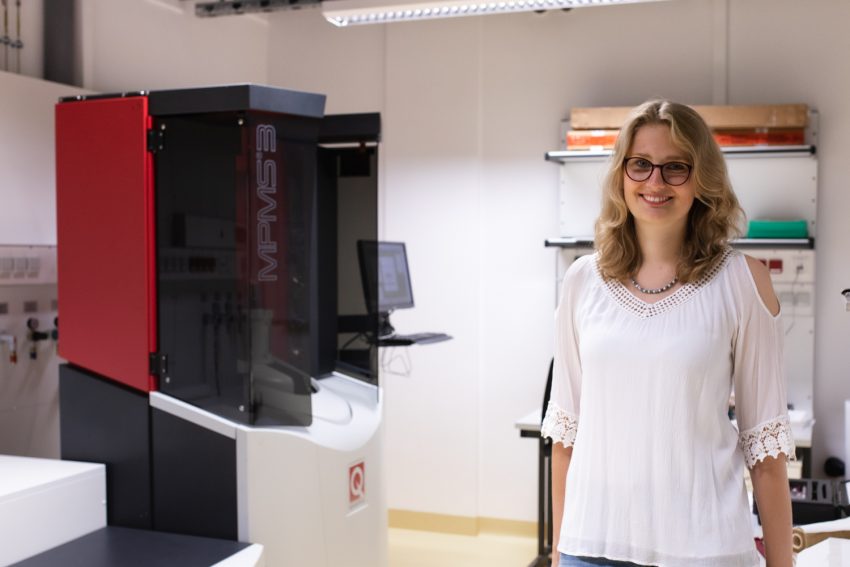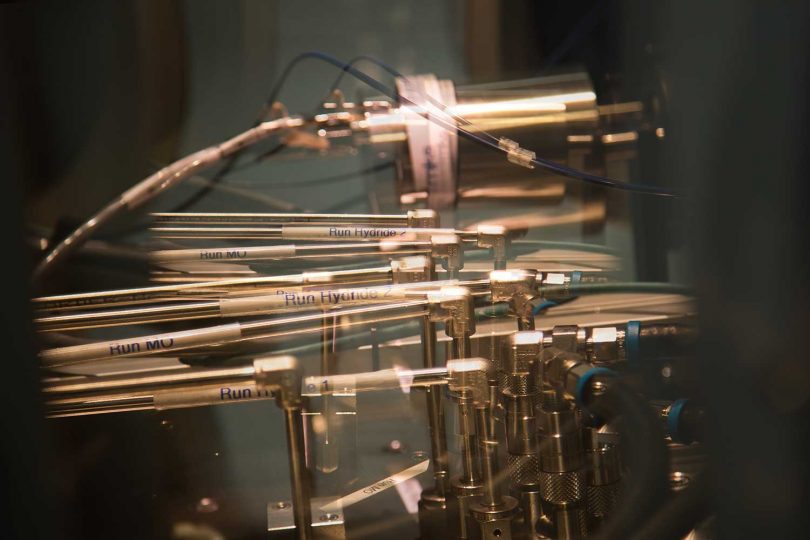Of Magnetic Moments and Iron Oxide Short portrait of Tamara Kahmann from the NanoMet Research Training Group
In the NanoMet Research Training Group, doctoral students measure ultra-small objects for technology, biology and medicine. The researchers at the college are looking for new approaches to measuring the smallest particles and thus pave the way for new technologies. Our external editor Dörte Saße spoke with doctoral student Tamara Kahmann about why it is good to earn a doctorate in the Research Training Group. Especially when you miss particles with varying properties.

Doctoral student Tamara Kahmann next to the MPMS at LENA. Picture credits: Max Fuhrmann/TU Braunschweig
Ms. Kahmann, for your PhD thesis you are working at the MPMS – a large scale instrument for magnetic properties – in the Laboratory for Emerging Nanometrology (LENA). What do you do there?
I study the characteristics of magnetic iron oxide nanoparticles. They have a size of about 10 to 200 nanometers and are thus much smaller than a human cell. Furthermore, due to their magnetic properties, they can be influenced by a magnetic field. They consist of a magnetic core that is protected by a shell. This shell can be functionalized with certain substances so that the particles can bind specifically to cells or proteins. This opens up a whole range of applications, especially in medicine.
For example, as a drug cab in so-called drug targeting, where the drugs are delivered directly to their target site in the body. Or in cancer therapy, where the iron oxide particles accumulate in the tumor and are then heated from the outside by an alternating magnetic field in order to selectively destroy the diseased tissue through hyperthermia. Or for immunoassays, with which viruses or antibodies can be detected. For example, my research group is currently investigating ways of detecting corona virus with the particles.
What exactly is your task?
For applications, it is important to know the behaviour of the particles in detail and to adapt it optimally to them – this is what I have been researching for one and a half years now as part of my doctoral thesis. The magnetic iron oxide particles we buy from companies differ greatly in their properties and behavior.
I am investigating the nanoparticles for their physical behavior, especially in MPMS: What influence does the magnetic field strength have on the magnetic moment “m” of the particles? How do the particle properties change depending on temperature? How do the particles behave in an alternating magnetic field? In addition, I use other measuring instruments at the Institute of Metrology and Electrical Engineering, which give different insights into the particle behaviour or complement the measuring range of the MPMS. These diverse characterization possibilities at the institute are a great advantage for my work.
What role does the NanoMet Research Training Group play in your doctorate?
First and foremost, my doctorate is funded by NanoMet for three years. In addition, there are funds for material resources or for attending conferences. However, the Research Training Group comprises much more:
You are also a member of the Braunschweig International Graduate School of Metrology (B-IGSM). During the semester, the two graduate schools offer a total of two events per week, plus a wide range of workshops, for example meetings at PTB and an annual summer school. This creates a close network with other doctoral students and the PTB. This exchange is what I appreciate most: you get insights into other research topics and assistance with professional and general challenges that arise during a doctoral thesis. For example, I was able to make comparative measurements at PTB, which helped a lot with the measurement settings of a measuring instrument. Furthermore, you have two supervisors, one from the TU and one from PTB, who support you should problems arise.
Most of the events are in English, which has also made writing papers or discussions at international conferences much easier for me. So far, NanoMet and the B-IGSM have helped me a lot with my PhD and I am glad to be a part of it.
Author: Dörte Saße

